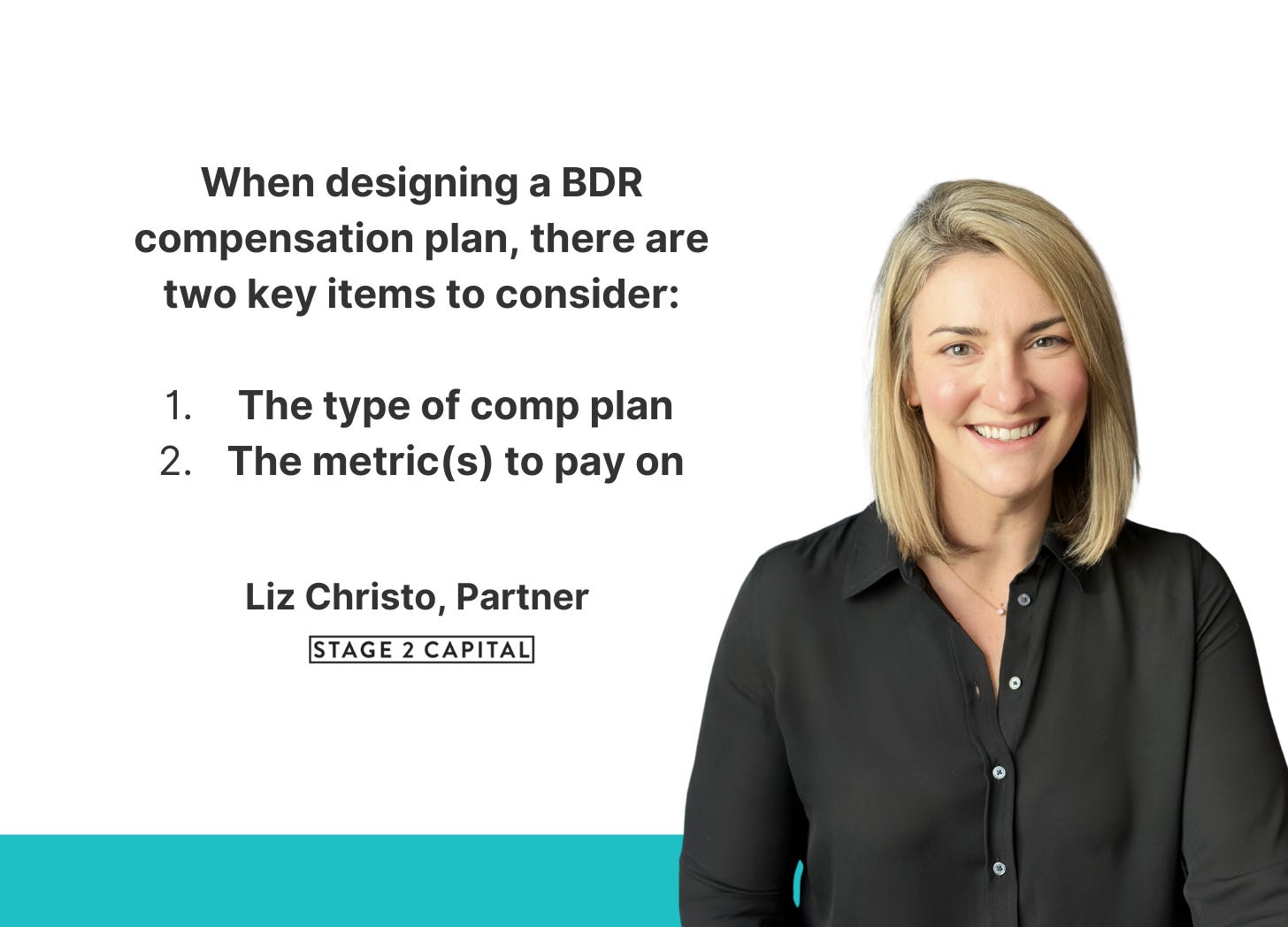by LIZ CHRISTO for Dear Stage 2
DEAR STAGE 2: I manage a 7-person outbound BDR team and want to roll out a new comp plan for the second half of the year. What are my options? Any recommendations on the best plans to use? ~New to designing comp plansSubscribe
DEAR NEW TO DESIGNING COMP PLANS: Let’s start with some simple advice — don’t assume your comp plan is broken. Before you throw out the current plan, ask yourself… What’s NOT working? What’s changed? If the plan is mostly working, consider making small tweaks or layering in short term SPIFFs.
But, if you need to start from scratch, let’s go back to the basics. Since comp plans are all about motivations and aligning incentives, you can begin by defining what behavior you want to drive — do you need more meetings? More qualified opportunities? More stakeholders engaged with your enterprise customers? Where in the funnel can you have the most impact?
Then you need to decide two things:
- The type of comp plan
- The metric(s) to pay on

Choosing the right comp plan for your team
Below are a few common models and some considerations for each:
- [MOST COMMON] Individual Performance Commission: Calculated based on individual performance metrics, such as the number of meetings booked, qualified opportunities generated, or new logos closed.
- Why we like it? Encourages individual motivation and accountability as BDRs directly benefit from their personal performance.
- Individual Tiered Commission Structure: Payouts based on reaching specific performance thresholds. For example:
- Tier 1: Achieving 80% of the monthly quota – X% commission
- Tier 2: Achieving 100% of the monthly quota – Y% commission
- Tier 3: Exceeding the monthly quota – Z% commission
- Why we like it? Provides incremental motivation as BDRs progress through different tiers.
- Team-Based Performance Commission: Calculated based on overall team performance against predefined goals, such as the number of qualified leads, revenue generated, or overall team targets.
- Why we like it? Encourages collaboration and shared learning as the entire team needs to work together to achieve shared goals.
- Pitfalls: Can result in lower individual motivation, as BDRs might feel their efforts are not directly rewarded.
Determining which metrics to pay on
In each of the above scenarios, you need to define the metric you are tracking and a goal. In my opinion, variable comp should be made up of two factors — one the BDR has control over, and one that ties them closely to revenue and the broader sales team and/or company target. A few examples to get you thinking:
- Let’s take a business with $12K ACV, short sales cycles (<1 month), a large horizontal market, and relatively high close rate (~25%) from first demo to customer. You likely want to incentivize volume. BDRs should be focused on booking as many demos, at new logos, as possible for AEs.
- But, what if you are trying to increase the ACV and move up market? You would want to align the BDR more closely to the AE’s performance and put more weight on the total revenue opportunity getting created, instead of just the number of meetings/logos. If fewer larger opportunities are more impactful for your business, then the BDR comp plan needs to reflect that. Otherwise, they will gravitate towards smaller deals where meetings are often easier to secure.
- What if you are selling to enterprise and have a small, defined list of target accounts? Your BDR metric might instead be focused on driving engagement across an account — the number of total contacts engaged at a company or seniority of contact engaged.
So, what does this look like in practice? Here are some examples of common two-metric plans:
- Variable comp = $X per meeting Meeting Occurred + % of Revenue
- Variable comp = $X per demo completed + $Y per new logo acquired
Or, here’s an example including a kicker or SPIFF that can be added:
- Variable comp = $X per Demo Occurred + $Y per Opp Created + % of Revenue
Bringing everything to life
Let’s say you have a BDR with an $80K OTE, where $50K is base salary and $30K variable comp. You’ve rolled out an individual performance comp plan based on the final example above, and you’ve set the targets at 16 Demos Occurred and 8 New Opportunities created per month.

The payout would look like this:
- Demos Occurred: (40%*$2.5K)/16 meetings = $62.5 each
- Opportunities Created : (60%*$2.5K)/8 opportunities = $187.5 each
- Kicker: 10% MRR on closed deals [not accounted for in OTE]
Lots of ideas here, but there’s no need to be overwhelmed by the number of factors to consider. Focus on the basics and design a plan that supports your company culture and desired outcomes.
Until next week!
